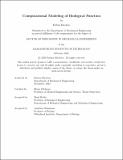Computational Modeling of Biological Function
Author(s)
Khodaee, Farhan
DownloadThesis PDF (23.44Mb)
Advisor
Edelman, Elazer
Terms of use
Metadata
Show full item recordAbstract
How biological function emerges from complex molecular patterns is a fundamental question in biology. Addressing this question requires a deep exploration of the concepts of genotype and phenotype, which serve as the foundation of this inquiry. This dissertation focuses on providing a quantitative approach through the lens of computation to dissect the dynamic relationship between genotype and phenotype. In particular, recent advancements in high-content genotyping methods, such as genome-wide association studies (GWAS) and single-cell RNA sequencing, have provided powerful tools for mapping the molecular basis of biological function, but also have introduced challenges due to the high dimensionality, vast combinatorial possibilities, and multimodal characteristics of the data. The overarching goal of this dissertation is first to provide a critical discussion on the theories of genotype and phenotype as they relate to biological function and propose new methods to map their relationship. Specifically, we present the integrated genetics framework designed to analyze and interpret the manifold of genotypes and their associated phenotypes simultaneously. We applied this approach to develop a multimodal foundation model for human transcriptomics at the cellular level. To further test the capabilities of this method, we apply it to dissect the aging process. The results of this study provide novel concepts and methods for analyzing the genetic data along with phenotypic information with higher resolution. Moreover, the results shed light on uncovered potential cross-tissue biomarkers that are undetectable through conventional gene expression analysis alone. Overall, this study aims to advance our understanding of the dynamic interplay between gene patterns and phenotypic manifestation and demonstrates the potential of computational modeling in uncovering new dimensions of cellular function and complexity.
Date issued
2025-02Department
Massachusetts Institute of Technology. Department of Mechanical EngineeringPublisher
Massachusetts Institute of Technology